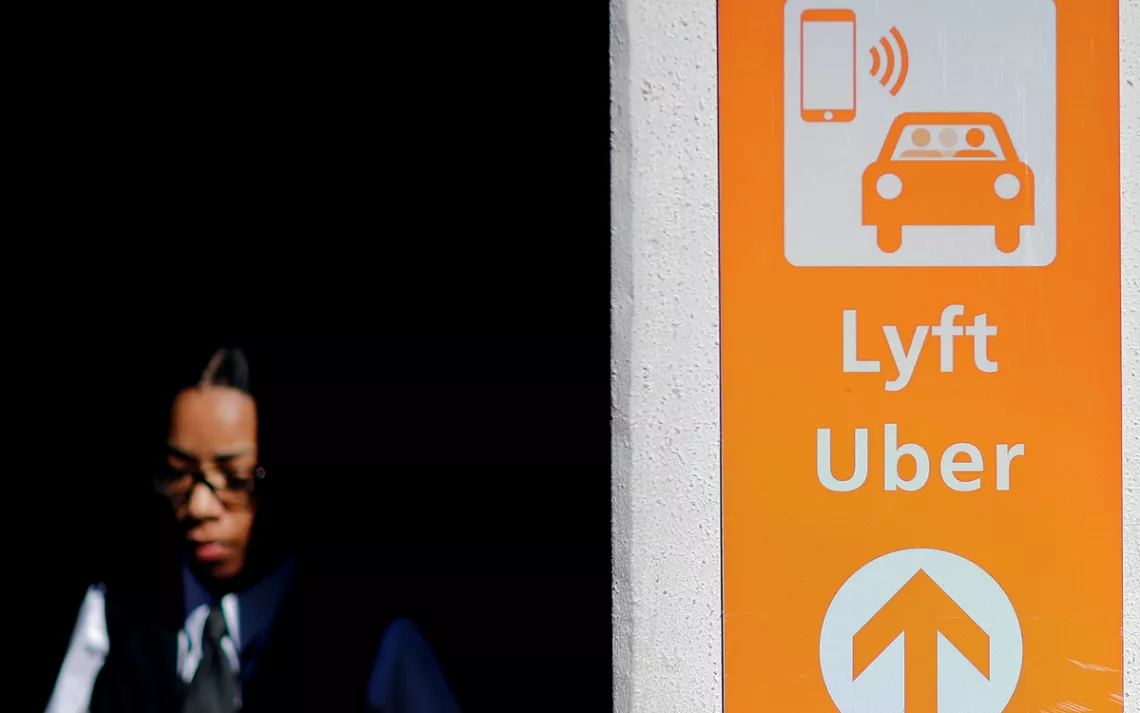Uber and Lyft Could Free Us From Cars—Or Kill Public Transit
Ride-hailing companies promised to revolutionize transportation, but it's just getting worse

The environmental benefits of ride hailing are iffy. Bike sharing, on the other hand, is an unmitigated good | Photo by David Goldman/AP Images
The disruptive environmental promise of ride-hailing companies like Uber and Lyft is to make private-car ownership a thing of the past. Why pay to own and maintain a car if you can simply summon a ride—maybe a self-driving one!—from your phone whenever you need one? Without cars, the theory goes, people might choose biking, scooting, walking, or public transit. In addition to green space where parking lots used to be, there would be a vast reduction in the climate impact of transportation—which recently outstripped power plants as the largest source of U.S. carbon emissions.
"As people get used to the idea of 'Maybe I don't have to take my car for that trip,'" says Adam Gromis, Uber's public policy manager for sustainability, "you're unchaining people from their personal car and getting them out into the world of shared mobility."
But as ride-hailing services (also known as transportation network companies) grow in popularity—they transported 2.6 billion passengers in 2017, 37 percent more than in 2016—the reality is less rosy. Caroline Rodier, a researcher at the National Center for Sustainable Transportation at the University of California, Davis, found that while Uber and Lyft have led to a 9-to-10-percent decline in car ownership, they have increased the total number of trips taken and the vehicle miles traveled.
In a recent report on what he calls "the new automobility," transportation expert Bruce Schaller notes that 60 percent of Uber and Lyft riders said that they would have otherwise walked, biked, or taken public transit. In Boston, a survey found that a significant portion of ride-hailing passengers actually owned a weekly or monthly transit pass, meaning they used Uber or Lyft even though they had already paid to ride the bus or subway. Transit ridership is down in 31 of 35 major metropolitan areas, and vehicle miles traveled have risen steadily since the end of the Great Recession. Ride hailing isn't the sole (or even the main) driver of these trends, but it is a significant contributor.
"What's needed is for people to give up their cars and for public mass transit to exist and be functional," says Regina Clewlow, the founder of Populus, a transportation data and analytics company. "If they just replace their cars with autonomous single-occupancy Ubers, there's no greenhouse gas emissions benefit."
The typical ride hailer is young, educated, affluent, and living in a densely populated city—precisely where low-emission transportation options like biking, walking, and transit work best. Researchers at the Metropolitan Planning Council in Boston are alarmed by the prevalence of ride hailing among people under 35, noting that they are developing lifelong habits that will be hard to change.
Ride-hailing services and transit could be complementary—making it possible, for example, for people to get a lift to or from a rail station. Phoenix and Denver are subsidizing Lyft trips to transit stations as a way to increase ridership. But Uber and Lyft are siphoning off far more transit riders than they're adding. "San Francisco and New York are the two places that are most intensively feeling this," Schaller says. "Other cities will feel it if this continues. The good news is that it simply can't continue, or cities will have gridlock."
Not all transportation wonks sense doom. Daniel Sperling, author of Three Revolutions: Steering Automated, Shared, and Electric Vehicles to a Better Future, argues that Uber and Lyft are our best hope for getting past individual automobile ownership. "All those environmentalists that are getting so upset—ask them if they have a better idea for transportation," he says. Ride hailing, he argues, "provides the pathway for creating a sustainable transportation system. There are really no other good ideas for how to do it."
Sperling's optimism, however, depends on the services providing well-used ride-pooling options—clustering riders traveling in the same direction into a single vehicle and allowing them to pay significantly less than if riding alone. "We see riders choosing UberPool about 20 percent of the time," Gromis says. (Overall carpooling rates, however, have declined from 20 percent of commute trips in 1980 to 9 percent today.)
Sperling believes that the convenience of ride hailing, if combined with the efficiencies of ride pooling, autonomous vehicles, and electric cars, could in fact deliver large reductions in carbon emissions. Unfortunately, ride hailers tend to value speed over saving a few bucks by using a carpool option. Schaller's study found that rather than convincing regular Uber and Lyft users to carpool, UberPool and Lyft Shared are attracting riders who would otherwise have walked, biked, or taken transit. California is combating this trend by requiring Uber and Lyft to reduce greenhouse gas emissions per passenger mile, mostly by adding zero-emission vehicles. It helps that both companies have recently acquired bike-share start-ups. Uber is now partnering with ticket vendor Masabi so users can purchase transit tickets, rent a bike, and hail a car using the same app.
(Bike sharing, unlike ride hailing, appears to be an unmitigated good for cities, with half of all bike-sharing members reporting a reduction in personal automobile use and many using bicycles to get to and from transit. Ridership for U.S. bike-sharing programs grew from 320,000 trips in 2010 to 88 million in 2017.)
All of this indicates that people are willing to change the way they get around—as long as the alternatives are convenient and predictable. "The question is not what kind of transportation system you want," Schaller says. "The question is what kind of city do you want to live in? If you want to drive everywhere, what you get is Houston."
This article appeared in the November/December 2018 edition with the headline "Automobiles Uber Alles."
 The Magazine of The Sierra Club
The Magazine of The Sierra Club